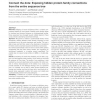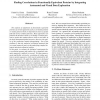40 search results - page 7 / 8 » High quality protein sequence alignment by combining structu... |
BMCBI
2004
13 years 10 months ago
2004
Background: In a previous paper, we introduced MUSCLE, a new program for creating multiple alignments of protein sequences, giving a brief summary of the algorithm and showing MUS...
BMCBI
2007
13 years 10 months ago
2007
Background: In past number of methods have been developed for predicting subcellular location of eukaryotic, prokaryotic (Gram-negative and Gram-positive bacteria) and human prote...
ECCB
2008
IEEE
14 years 4 months ago
2008
IEEE
Motivation: Mapping of remote evolutionary links is a classic computational problem of much interest. Relating protein families allows for functional and structural inference on u...
BMCBI
2008
13 years 10 months ago
2008
Background: Aligning homologous non-coding RNAs (ncRNAs) correctly in terms of sequence and structure is an unresolved problem, due to both mathematical complexity and imperfect s...
BIBE
2006
IEEE
14 years 4 months ago
2006
IEEE
The analysis of alignments of functionally equivalent proteins can reveal regularities such as correlated positions or residue patterns which are important to ensure a specific f...


